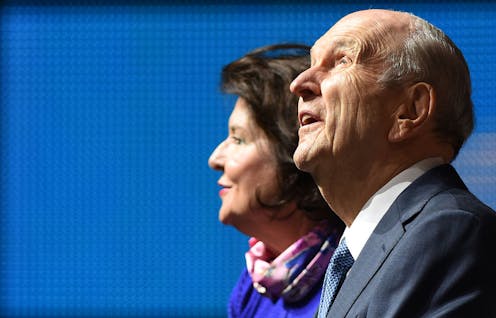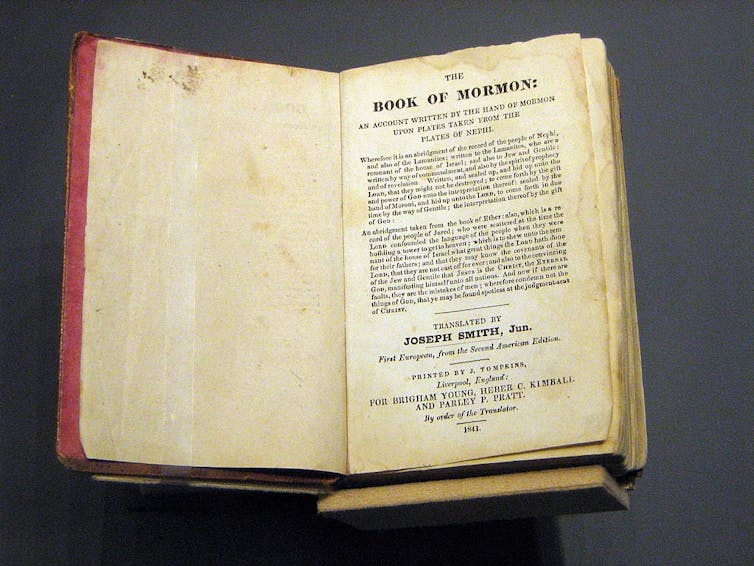As Russell M. Nelson turns 100, a look back at one of the words that will define his legacy – and the controversial term’s 200-year history
- Written by Konden Smith Hansen, Lecturer of Religious Studies, University of Arizona
 Russell M. Nelson, with his wife, Wendy Nelson, looks at the audience after speaking at a devotional in 2019 in Orlando, Fla.Paul Hennessy/NurPhoto via Getty Images
Russell M. Nelson, with his wife, Wendy Nelson, looks at the audience after speaking at a devotional in 2019 in Orlando, Fla.Paul Hennessy/NurPhoto via Getty ImagesOn Sept. 9, 2024, The Church of Jesus Christ of Latter-day Saints will host a broadcast to celebrate the “life and teachings” of Russell M. Nelson, its president and prophet. Nelson, whose 100th birthday falls on that day, has asked church members to celebrate by reaching out to someone in need.
The centenarian has been a reactionary reformer: an energetic leader who streamlined bureaucracy and ended the church’s century-long relationship with the Boy Scouts, while reaffirming its opposition to LGBTQ+ relationships and identities. He steered the church unapologetically through storms of public scrutiny, including accusations that the church had concealed the value of its investments. For the faithful, Nelson represents God’s mouthpiece on Earth.
Yet one of his initiatives made an impact that rippled far beyond the church. In 2018, he surprised observers by declaring the use of the word “Mormon” a “major victory for Satan,” insisting on the use of the church’s full name. Individuals were to be recognized by their institutional affiliation, as “members of The Church of Jesus Christ of Latter-day Saints.”
The name of the church was given by God, and shortening it erases “all that Jesus Christ did for us,” Nelson argued. Yet adherents have long self-identified as Mormons, so the rebrand felt like a novelty to some members.
As a university lecturer teaching courses on American religion and Mormonism, I was one of many who wrestled with this change in terminology – and saw the confusion it created for my students and colleagues. For almost two centuries, the word “Mormon” has framed how Americans think about and discuss this faith.
Birth of a church
The name Mormon comes from the title of the Book of Mormon, a religious text unique to the faith. Founder Joseph Smith, who organized the church in 1830, believed he had been instructed by God to restore Jesus’ true church. He claimed that an angel had led him to uncover and translate ancient gold plates that detailed the religious history of an ancient civilization in the Americas, founded by Israelites who fled Jerusalem.
 An 1841 edition of the Book of Mormon, on display in the museum at the Springs Preserve in Las Vegas.Prosfilaes/Wikimedia Commons, CC BY
An 1841 edition of the Book of Mormon, on display in the museum at the Springs Preserve in Las Vegas.Prosfilaes/Wikimedia Commons, CC BYEarly critics mockingly attached the word Mormon to the movement, but Smith insisted that in the book’s original language, the word meant “literally, ‘more good.’” By the time Smith was killed by a mob in Illinois in 1844, his followers had embraced the word.
After Smith’s death, Mormons split into different factions, with the largest group traveling by foot and wagon to the far American West. Yet, the group’s evolving practices continued to spark controversy. Polygamy and the church’s political and economic influence contributed to decades of animosity between Mormons and the rest of the nation.
The United States began seizing church property and imprisoning polygamist leaders, coercing church president Wilford Woodruff to end official support for polygamy in 1890.
A new debut
Three years later, at the Chicago World’s Fair, the church rebranded Mormonism, presenting Mormon pioneers as an embodiment of the values of the American frontier.
Woodruff, then 86 years old, spoke of himself as Utah’s oldest living pioneer and of Mormons as a people who built the American West. The Mormon Tabernacle Choir performed at the fair, reintroducing Mormons to the wider public as a sophisticated and artistic people. The crowd shouted, “Three cheers for the Mormons!” The Chicago Herald wrote, “Mormons and gentiles came together as friends.”
 The Great Basin at the Chicago World’s Fair in 1893.Chicago History Museum/Getty Images
The Great Basin at the Chicago World’s Fair in 1893.Chicago History Museum/Getty ImagesDespite this, many Americans still distrusted Mormons. In 1903, high-ranking church official Reed Smoot was elected to the U.S. Senate, which provoked national outcry and led to Senate hearings that lasted until 1907. The hearings substantiated charges that the practice of polygamy persisted but exonerated Smoot as an individual. As Smoot argued, Mormons were independent of the institutional church and thus trustworthy Americans. He convinced his fellow senators that if the church’s teachings came into conflict with his conscience or oath of office, then, as a Mormon, he would uphold the latter.
Following Smoot’s lead, the church embraced the trappings of American patriotism and doubled down against plural marriage. These moves won the Latter-day Saints powerful political allies, including Theodore Roosevelt, who disliked the institutional church but viewed Mormons themselves as intensely moral and patriotic.
‘Meet the Mormons’
Ab Jenkins, a race car driver whose records made him an international celebrity in the 1930s, capitalized on this new image of Mormon individuality and wholesomeness. The “Mormon Boy” credited his clean, church-approved lifestyle for his success. On his car, the Mormon Meteor, Jenkins rejected alcohol and cigarette endorsements and instead brandished a sign that read, “Yes, I’m a Mormon.”
 Ab Jenkins starts a 1939 test run in his race car, the Mormon Meteor III, on Utah’s Bonneville Salt Flats.Underwood Archives/Getty Images
Ab Jenkins starts a 1939 test run in his race car, the Mormon Meteor III, on Utah’s Bonneville Salt Flats.Underwood Archives/Getty ImagesFor several decades, other Mormon celebrities like family band The Osmonds and golfer Johnny Miller continued to shape positive public views of Mormons – hitting a high-water mark in 1977, when Gallup found that only 18% of Americans held unfavorable views.
Church efforts to influence social issues, however, such as its decades-long opposition to the Equal Rights Amendment, eventually took a toll. By 1991, public opinion of Mormons had fallen dramatically, with 37% of Americans viewing them unfavorably – and leaders decided that another rebrand was in order.
The previous year, senior leader Gordon B. Hinckley had admonished members to make the word Mormon “shine with added luster.” When he became president in 1995, Hinckley worked to reframe how the public saw Mormons, arguing on the “60 Minutes” TV show that Mormons were “not a weird people.”
The Salt Lake City Olympics in 2002 pushed Mormonism into the national spotlight, and that same year, the church launched its major website, Mormon.org, with stories and headlines liberally using the term “Mormon.” A media campaign followed a decade later, featuring prominent members declaring, “I’m a Mormon.” Ordinary members were then encouraged to upload their own “I’m a Mormon” profiles to this website and share them on their own social media accounts.
 The Latter-day Saints temple in downtown Salt Lake City, center, as an Olympic banner drapes the church office building next door during the 2002 Games.George Frey/AFP via Getty Images
The Latter-day Saints temple in downtown Salt Lake City, center, as an Olympic banner drapes the church office building next door during the 2002 Games.George Frey/AFP via Getty ImagesMitt Romney’s Republican nomination for the 2012 presidential election and the popularity of the satirical “Book of Mormon” musical pushed Mormons again into the national spotlight. In 2014, the church produced a documentary titled “Meet the Mormons,” shown in theaters across the U.S., which apostle Jefferey R. Holland explained was to “show people what we’re really like.”
In 2017, a Pew Research Center survey’s “feeling thermometer” found public opinion of Mormons to have risen to the “somewhat warmer” rating of 54, a 6-point increase from 2014.
‘More good’?
That said, the church’s relationship to the word Mormon has always been complex. As far back as 1990, Nelson was already warning fellow Latter-day Saints that Mormon was “not an appropriate alternative” for the church’s full name. During the 2002 Olympics, the church advised media that the nickname was acceptable for individuals but not to refer to the institution itself.
Overall, however, I would argue the church has used the word Mormon to improve public opinion for more than a century. Part of this branding downplayed popular fears about the church and its influence – allowing outsiders to develop favorable views toward Mormons, even if they disliked the institution itself.
In March 2023, a Pew Research poll reported a low point in public opinion of Mormons, falling for the first time below every other measured group. A quarter of Americans held “unfavorable views of Mormons,” while only 15% held “favorable” ones.
Mormon had been an important term in engaging those outside the faith, particularly in countering negative perceptions. Nelson’s legacy will thus have less to do with whether the term disappears from popular use but rather with how much outsiders associate it with “more good” – both institutionally and individually.
Konden Smith Hansen does not work for, consult, own shares in or receive funding from any company or organization that would benefit from this article, and has disclosed no relevant affiliations beyond their academic appointment.
Authors: Konden Smith Hansen, Lecturer of Religious Studies, University of Arizona
